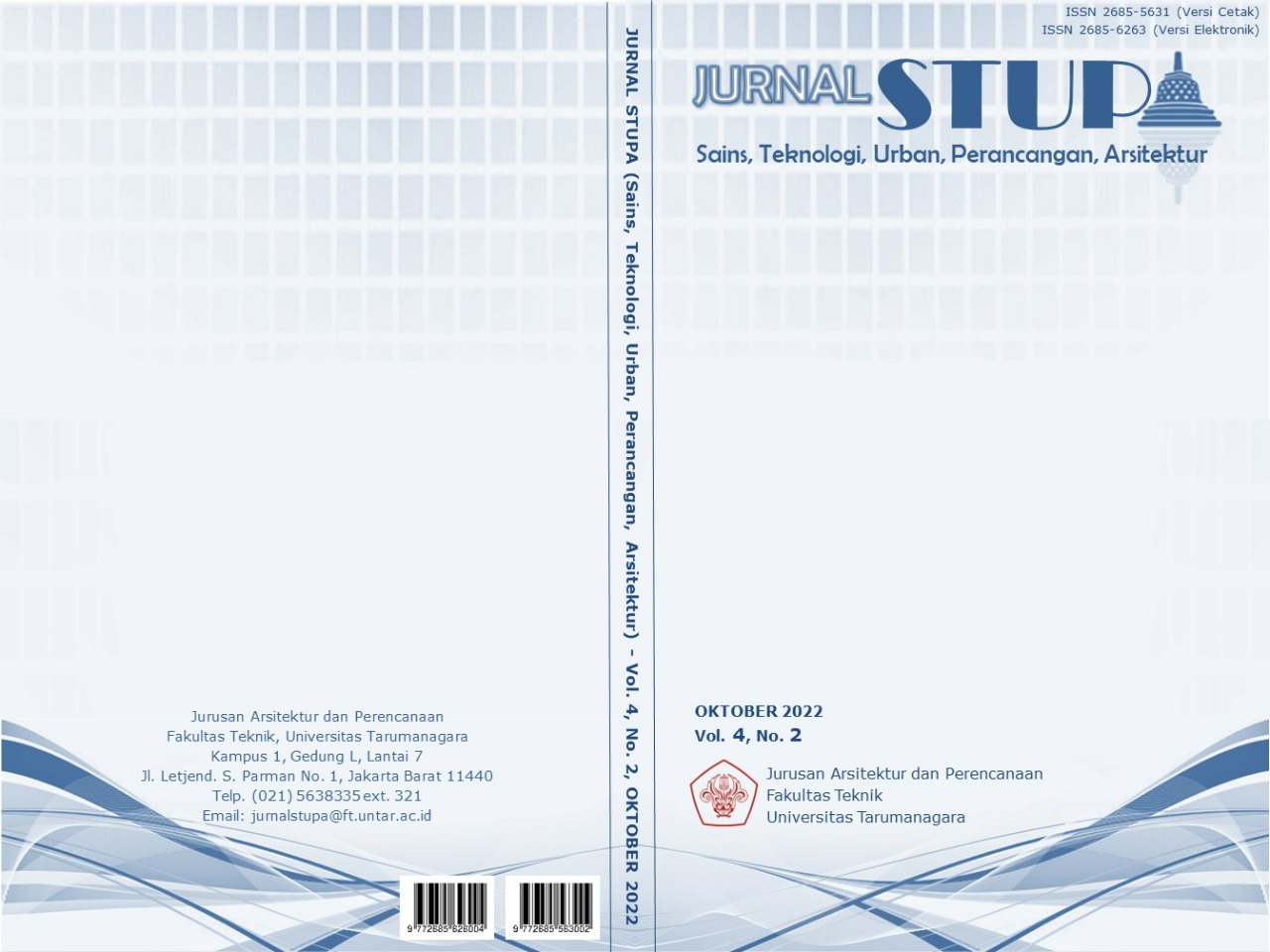PENERAPAN MEMORABLE TOURISM EXPERIENCE (MTE) PADA PERANCANGAN WISATA GASTRONOMI DAN BATIK BETAWI SEBAGAI URBAN ACUPUNCTURE DI SETU BABAKAN
Main Article Content
Abstract
Culture is always attached to humans. Whenever and wherever the area is, humans always have a culture because it is a way of life that develops and is shared by a group of people that is passed down from generation to generation. The first function of culture in people's live is as identity. The presence of culture is a characteristic of certain groups. Culture and creativity have the potential to provide social, economic and spatial benefits for cities and communities, thereby contributing to the competitiveness and sustainability of cities. The culture that is grasped will show where the region and its identity come from. Betawi is the original culture identity of Jakarta which is divided into several types, including clothing, handicrafts, and food. This tourism project, which is located in Setu Babakan Betawi Village, aims to preserve the history of Betawi culinary in Indonesia, especially for the younger generation who are currently starting to lose interest in regional food. Not only that, this project also has a Betawi batik activity program which aims to introduce and preserve the way of batik using handpicking techniques and natural dyes that are environmentally friendly. The method used to support this project is the principle of urban acupuncture and the concept of Memorable Tourism Experience. The architectural design in this paper are expected to be able to embrace the potentials of Betawi culture in Setu Babakan, connect tourists with local communities, improve the quality of life and environment through the memorable space experience.
Keywords: Betawi; culture; memorable tourism experience; tourism; urban acupuncture
Abstrak
Kebudayaan akan selalu lekat dengan kehidupan manusia. Entah kapan dan di manapun daerahnya, manusia akan selalu berbudaya. Pasalnya, budaya merupakan cara hidup yang terus berkembang serta dimiliki bersama oleh kelompok orang yang diwariskan secara turun temurun dari generasi ke generasi. Fungsi pertama budaya dalam kehidupan masyarakat adalah sebagai identitas. Kehadiran budaya merupakan ciri khas terhadap suatu kelompok tertentu. Budaya dan kreativitas memiliki potensi yang besar untuk memberi manfaat baik secara sosial, ekonomi, maupun spasial kota dan masyarakat, sehingga memberikan kontribusi pada daya saing dan keberlanjutan dari suatu kota. Budaya yang digenggam akan menunjukkan di mana daerah dan identitasnya berasal. Budaya Betawi merupakan identitas asli Kota Jakarta yang terbagi menjadi beberapa jenis, antara lain busana, kerajinan tangan, serta makanan. Proyek wisata yang terletak di Kampung Betawi Setu Babakan ini bertujuan untuk mempreservasikan sejarah kuliner Betawi di Indonesia, terkhusus bagi generasi muda yang saat ini mulai kehilangan minatnya terhadap makanan daerah. Tidak hanya itu, proyek ini juga memiliki program aktivitas batik Betawi yang bertujuan untuk memperkenalkan dan melestarikan cara membatik dengan teknik pencoletan dan pewarna alami yang ramah lingkungan. Metode yang digunakan untuk mendukung proyek ini adalah prinsip urban acupuncture dan konsep Memorable Tourism Experience. Hasil perancangan arsitektur dalam tulisan ini diharapkan dapat merangkul potensi-potensi kebudayaan Betawi yang tersebar di Setu Babakan, menghubungkan wisatawan dengan komunitas lokal, serta meningkatkan kualitas hidup masyarakat dan lingkungannya melalui pengalaman ruang yang dihadirkan
Article Details

This work is licensed under a Creative Commons Attribution-NonCommercial-ShareAlike 4.0 International License.
This work is licensed under a Jurnal Sains, Teknologi, Urban, Perancangan, Arsitektur/ STUPA Creative Commons Attribution-NonCommercial-ShareAlike 4.0 International LicenseReferences
De Sola Morales, M. (2008). A Matter of Things. Rotterdam: NAi.
Indonesia, Liputan6, 2020, Biasanya Ramai Pengunjung, Begini Kondisi Terkini Setu Babakan Pascapenutupan, diunduh dari https://www.liputan6.com/photo/read/4204194/foto-biasanya-ramai-pengunjung-begini-kondisi-terkini-setu-babakan-pascapenutupan?page=1
Lerner, J. (2011). O Urban Acupuncture: Social Enterprise Article. Harvard Business Review
Richards, G., and Wilson, J. (2006). Developing Creativity in Tourist Experiences: A Solution to the Serial Reproduction of Culture?. Tourism Management, 27: 1209-1223.
Schulz, C. N. (1980). Genius Loci: Towards A Phenomenology of Architecture. London: Academy Editions.
Schwarzer, M. (2005). Architecture and Mass Tourism. In J. Ockman, and S. Frausto (eds.). Architourism, NY: Columbia Book of Architecture.
Sutanto, A. (2020). Peta Motode Desain. Jakarta: Universitas Tarumanagara.
Verinita. (2016). Pengukuran Memorable Tourism Experience Scale (MTES) dengan pendekatan Kim Ritchie Mccormick (2012) untuk meningkatkan intensi berkunjung kembali ke desa Wisata Rantih Kota Sawahlunto provinsi Sumatera Barat. Prosiding Seminar Nasional ASBIS 2016.
Ye, HelenYi and Tussyadiah, Iis P. (2016). Tourists' Transformation Experience: From Destination Architecture to Identity Formation. Travel and Tourism Research Association: Advancing Tourism Research Globally.



